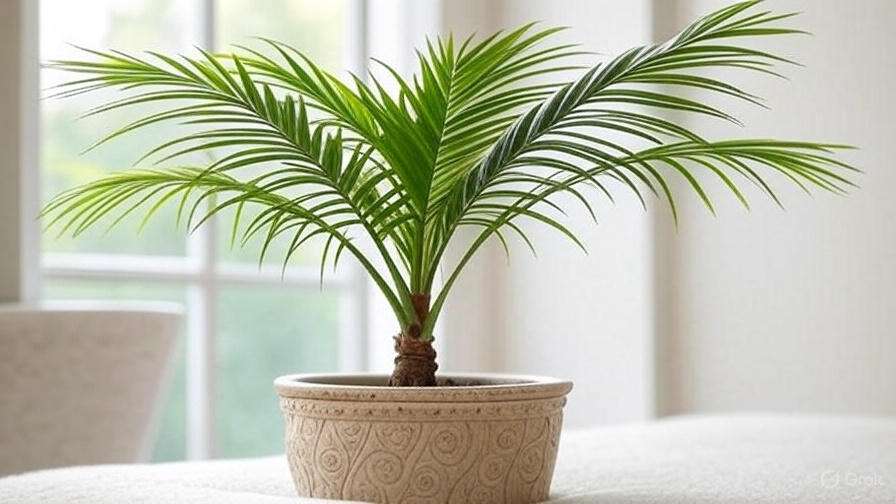
Baby Palm Tree Care: Essential Tips for Healthy Growth and Vibrant Leaves
Bringing a baby palm tree into your home or garden can instantly transform your space into a tropical paradise 
In this guide, we’ll walk you through the essential tips to ensure your baby palm tree grows strong, healthy, and vibrant. From choosing the right soil and watering schedule to providing the perfect amount of sunlight, we’ve got you covered. By following these simple care strategies, you’ll set your baby palm tree up for a long and healthy life. Ready to help your baby palm tree flourish? Let’s dive in!
Table of Contents
ToggleUnderstanding Baby Palm Trees 

Caring for baby palm trees is a rewarding experience that sets the foundation for healthy growth throughout their lifespan. These young palms require specific care to thrive, and understanding their needs from the start is essential. Let’s dive into the key elements of caring for your baby palm tree, making sure it grows strong and healthy.
What is a Baby Palm Tree? 
A baby palm tree refers to a young or small palm plant that’s just starting its growth journey. Typically, these are seedlings or young palms that haven’t yet reached their full size. Baby palms can vary widely in shape, size, and care needs depending on the species, but they share a few common characteristics: soft, vibrant green fronds, a slender trunk (or no trunk at all), and a compact growth habit.
In general, baby palm trees are incredibly popular for indoor spaces, patios, or gardens. They add a tropical feel to any environment and can be easier to care for than mature palms.
Baby palm trees come in many varieties, including the Areca Palm, Pygmy Date Palm, and Sago Palm. These little plants are perfect for beginners, as they don’t require as much maintenance as older palms. But don’t be fooled—while they may start small, with the right care, they can grow into impressive trees!

Why Baby Palm Trees Need Special Care 
Caring for baby palm trees is different from tending to mature palms. These young plants are still in their early stages of growth, and their needs are more specific. Here’s why special attention is crucial for their health:
1. Sensitive Roots and Growth Stages
Baby palm trees have delicate, developing root systems that are more vulnerable to overwatering, underwatering, and physical damage. Unlike mature palms, which are more resilient, these young plants need their roots to establish a strong foundation for future growth.
To promote healthy root development, ensure the soil is well-draining and not soggy. A balanced watering schedule is key—baby palms need moisture, but they can’t handle excessive wetness.
2. Temperature and Humidity Needs 
Baby palm trees are more sensitive to extreme temperatures and fluctuating humidity levels. These plants thrive in warm, humid environments, and any sudden drops in temperature can cause stress, slowing their growth or even causing them to wilt.
Try to keep them in temperatures between 65°F and 85°F (18°C-29°C). If you’re growing your palm indoors, placing it near a humidifier or misting it lightly can help boost the humidity around it.
3. Proper Sunlight Exposure 
While adult palms are quite adaptable to sunlight, baby palms are more sensitive. They need plenty of bright, indirect light to thrive. Too much direct sun can scorch their delicate leaves, leading to brown tips and leaf damage.
Place your baby palm tree in a spot where it receives filtered light or morning sunlight. If you’re growing it indoors, a spot near a window with sheer curtains is ideal.
4. Nutrient Requirements
Unlike mature palms that can survive with minimal feeding, baby palms need more consistent nutrients to fuel their rapid growth. Using a balanced, slow-release fertilizer can provide the steady nourishment they need.
Feed your baby palm during its growing season (spring and summer) every 4-6 weeks. Be sure to avoid fertilizing in winter when growth slows down.
5. Repotting with Care
As your baby palm grows, it will eventually outgrow its pot. However, be careful when repotting. The process can be stressful for young palms, so choose a pot that’s only slightly larger than the current one to prevent root shock.
Repotting should be done in spring or early summer to allow your baby palm to adjust without the added stress of winter’s cold temperatures.
By understanding these specific care needs, you can give your baby palm tree the best start in life, setting it up for long-term success and healthy, vibrant growth 
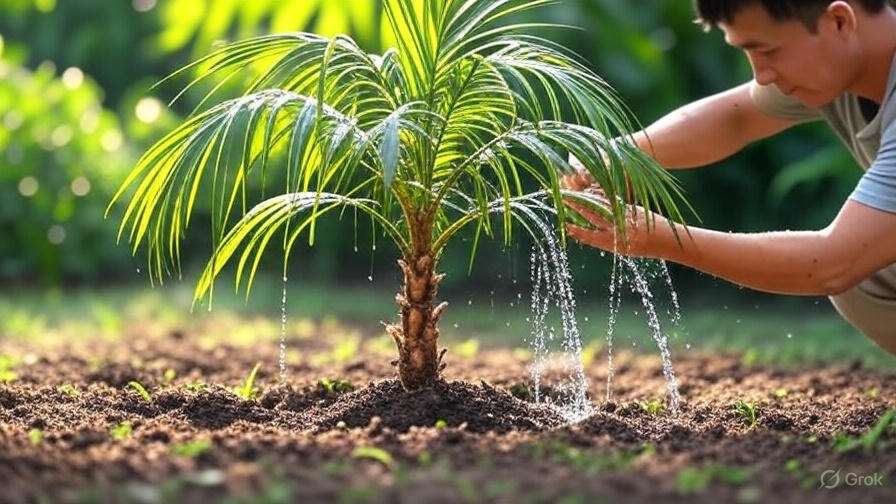
Ideal Growing Conditions for Baby Palm Trees 
Baby palm trees are a beautiful addition to any garden or home, but they need the right environment to grow strong and healthy. Understanding the ideal growing conditions will set your palm tree up for success. Here’s what you need to know:
1. Light Requirements 
Baby palms thrive in bright, indirect light. Direct sunlight can scorch their delicate leaves, so place them near a window with sheer curtains or in a spot where they get morning sunlight. If grown outdoors, choose a location that offers partial shade. Some palms, like the Areca Palm, can tolerate lower light but grow best with more exposure.
2. Temperature Needs 
Palms are tropical plants, so they love warmth! The ideal temperature for a baby palm tree is between 65°F and 75°F (18°C to 24°C). Keep them away from drafts, air conditioning vents, or any areas with sudden temperature shifts. If you’re growing them outside, ensure that temperatures don’t dip below 50°F (10°C) in winter.
3. Soil Type and Drainage 
Good soil is crucial for palm health. Opt for well-draining, slightly acidic soil. A mix made for palms or cacti works great! Avoid heavy, clay-like soil that holds too much moisture, as this can lead to root rot. Make sure your pot has drainage holes to allow excess water to escape.
4. Watering Guidelines 
Baby palms like their soil to be kept moist but not soggy. Water them when the top inch or so of the soil feels dry. Over-watering is one of the biggest mistakes palm owners make. Ensure proper drainage, and never let your baby palm sit in standing water.
5. Humidity Preferences 
Palms are moisture-loving plants! They thrive in high humidity levels (50% or more). If your home is dry, especially in winter, consider using a humidifier or misting your baby palm regularly. Placing your palm in a bathroom with good light is also a great way to boost humidity.
6. Fertilization 
Feed your baby palm with a balanced, water-soluble fertilizer every 4-6 weeks during the growing season (spring through summer). Avoid over-fertilizing, as this can damage the roots. In the colder months, reduce fertilization since palm growth slows down.
7. Potting and Repotting 
As your palm grows, it will need more space. Repot your baby palm every 1-2 years, or when you notice roots peeking out of the drainage holes. Choose a pot that’s only slightly larger than the current one to prevent the roots from becoming waterlogged.
By providing the right light, temperature, soil, and care, you’ll help your baby palm tree thrive and grow into a stunning addition to your home or garden. 

Watering and Fertilizing Your Baby Palm Tree 

Taking care of your baby palm tree’s watering and fertilizing needs is essential for its growth and long-term health. When done correctly, these practices will help your palm develop a strong root system and vibrant fronds. Let’s break down how to keep your baby palm tree hydrated and well-fed!
Watering Your Baby Palm Tree 
Baby palm trees need consistent moisture, but they don’t like to sit in soggy soil. Overwatering can lead to root rot, so finding a balance is key. Here’s how to water your palm tree properly:
- Water When the Top Inch of Soil is Dry: Stick your finger into the soil. If it feels dry up to the first inch, it’s time to water. If it’s still moist, hold off.
- Water Deeply, but Not Too Often: When you water, make sure to saturate the soil thoroughly. This encourages the roots to grow deep and strong. However, avoid watering every day. In most cases, once a week is enough—more often in hot weather and less in cooler months.
- Ensure Proper Drainage: Always use a pot with drainage holes. Standing water can cause the roots to suffocate and rot. If your palm tree is in the ground, make sure the soil drains well.
- Adjust for Humidity: Palms thrive in humid environments. If your home is dry, consider misting the leaves every couple of days or placing a humidifier nearby.
Fertilizing Your Baby Palm Tree 
Fertilizing your baby palm tree is crucial for providing the nutrients it needs to grow strong and healthy. Palms are sensitive to the type and amount of fertilizer, so it’s important to get it right.
- Choose a Palm-Specific Fertilizer: Palms have unique nutritional needs. A high-quality, slow-release fertilizer designed for palms will ensure your tree gets the right balance of nutrients like potassium, magnesium, and micronutrients.
- Feed During the Growing Season: Baby palms are most active during the spring and summer months. Apply fertilizer every 4-6 weeks during this time to support their growth. In the fall and winter, reduce feeding as the tree slows down.
- Follow the Instructions: Over-fertilizing can harm your palm, so always follow the manufacturer’s instructions on the fertilizer packaging. Generally, a light application is better than too much.
- Watch for Signs of Deficiency: If your palm’s leaves start to yellow or show other signs of nutrient deficiencies, consider adjusting the fertilizer. This may be a sign that it needs more nitrogen or magnesium.
By following these simple watering and fertilizing tips, your baby palm tree will have everything it needs to grow strong and healthy. With just the right care, it will thrive for years to come, turning into a stunning addition to your home or garden.
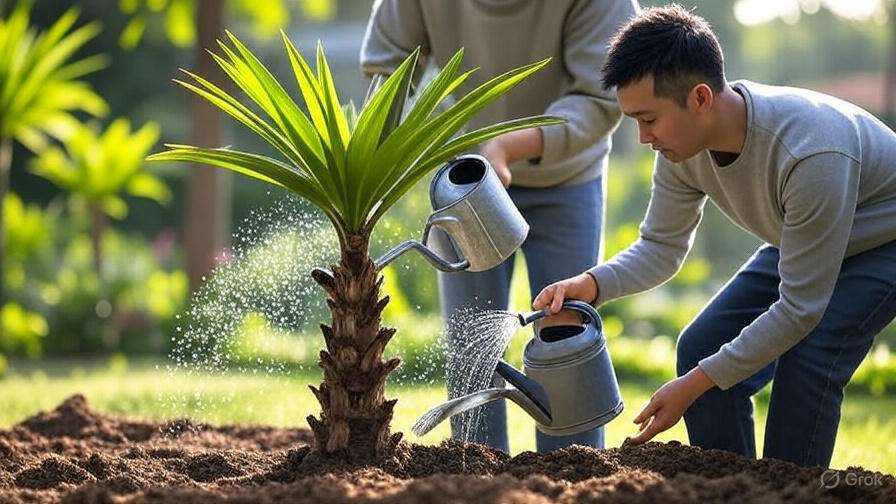
Pruning and General Maintenance for Baby Palm Trees 
Taking care of your baby palm tree involves more than just watering and ensuring it gets sunlight. Pruning and general maintenance are key to promoting healthy growth and a beautiful appearance. Here’s how you can keep your palm in top shape as it grows.
1. Pruning Dead or Damaged Fronds 
Pruning is essential for removing dead, yellowing, or damaged fronds. These fronds not only make your palm look unkempt but can also attract pests or disease. To keep your baby palm healthy, remove these fronds by cutting them off at the base using sharp, clean pruning shears.
- When to prune: Only remove fronds that are completely dead or severely damaged. Avoid cutting healthy fronds since palms need them to produce energy.
- How to prune: Always cut at an angle, close to the trunk, to avoid damaging the tree. Be careful not to cut into the trunk, as this could harm the tree.
2. Cutting Back New Growth 
Sometimes, palms will produce extra growth that is crowded or growing too close to other fronds. You can carefully trim back these shoots to give your palm a more open, airy look. This helps with airflow and sunlight penetration, both of which are crucial for your palm’s health.
- Tip: Never cut more than 20% of the palm’s fronds at once. Over-pruning can stress the tree, slowing its growth.
3. Managing Palm Tree Height 
As your baby palm tree matures, it will naturally grow taller. If you have limited space, you can manage the height by pruning the top of the trunk. However, this is generally only recommended for certain types of palms. Always research your specific palm variety to see if this is a viable option.
4. Cleaning Up Fallen Leaves and Debris 
Palm trees can shed fronds, which accumulate around the base of the tree. Regularly clean up these fallen leaves and debris to prevent mold, mildew, and pests from settling in. Additionally, keeping the area around your palm free from excess debris will help it look tidy and thrive.
5. Fertilizing for Healthy Growth 
In addition to pruning, your baby palm tree needs proper nutrition. Use a balanced fertilizer designed for palm trees, and apply it during the growing season (spring and summer). This will encourage strong, vibrant growth. Be sure to follow the package instructions to avoid over-fertilizing, which can harm the tree.
6. Inspecting for Pests 
Regularly check your palm tree for signs of pests like spider mites, aphids, or mealybugs. If you spot any, take action quickly. Use an insecticidal soap or natural remedies like neem oil to treat the pests. Keeping the fronds clean and healthy also helps prevent infestations.
Final Tips for Baby Palm Tree Care 
- Water deeply but infrequently to encourage deep root growth.
- Keep the soil well-draining to prevent root rot.
- Monitor the tree for any signs of stress, like yellowing leaves or slow growth, which may indicate a care issue.
By regularly pruning and maintaining your baby palm tree, you’ll promote healthy growth, prevent diseases, and ensure your tree flourishes for years to come!
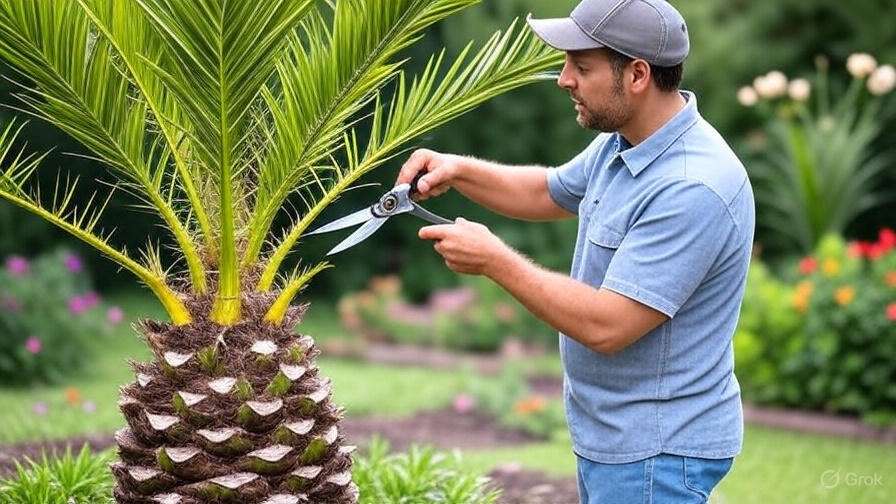
Common Problems and Troubleshooting 
Even with the best care, your Tree Royal Palm may encounter a few issues along the way. Fortunately, most of these problems are easy to spot and fix. Here’s a guide to some common problems and how to troubleshoot them.
1. Yellowing Leaves 
One of the most common issues with Tree Royal Palms is yellowing leaves. This can be caused by several factors:
- Overwatering: Too much water can lead to root rot, causing the leaves to turn yellow. Make sure the soil drains well and only water when the top inch of soil feels dry.
- Nutrient Deficiency: If your palm isn’t getting enough nutrients, especially nitrogen, the leaves can turn yellow. Fertilize with a balanced, slow-release fertilizer to provide essential nutrients.
- Pests: Check for pests like spider mites or mealybugs that might be causing damage to the leaves.
Solution: Adjust watering habits, add fertilizer, or treat the plant with an organic pesticide if pests are detected.
2. Brown Tips on Leaves 
Brown tips can make your palm look unhealthy, but they are often easy to fix. Here’s what to look for:
- Low humidity: Royal Palms love humidity. If the air is too dry, the tips of the leaves can dry out and turn brown.
- Over-fertilization: Too much fertilizer can burn the roots, causing leaf tips to brown.
- Water Stress: Either too much or too little water can stress the plant, leading to brown leaf tips.
Solution: Increase humidity around the plant by misting the leaves or placing a humidifier nearby. Ensure you’re not over-fertilizing and that you’re watering the palm properly.
3. Wilting or Drooping Leaves 
If your Tree Royal Palm’s leaves are drooping or wilting, it’s a sign that something’s wrong. Common causes include:
- Underwatering: Palms need regular water, and if they aren’t getting enough, they’ll begin to wilt.
- Overwatering: Conversely, too much water can suffocate the roots, leading to wilting.
- Root Rot: This is a serious condition caused by prolonged overwatering, leading to mushy roots and poor nutrient uptake.
Solution: Check the soil’s moisture level regularly. If it’s too dry, water thoroughly. If it’s too wet, allow the soil to dry out before watering again. If you suspect root rot, gently remove the plant from its pot to check the roots and trim away any damaged parts.
4. Pests 
Like all plants, Tree Royal Palms are susceptible to pests. The most common culprits are:
- Spider Mites: Tiny, red pests that can cause the leaves to become speckled or discolored.
- Mealybugs: These white, cotton-like pests hide in the crevices of the palm and cause a sticky residue on the leaves.
- Scale Insects: Small, flat insects that can be found on the underside of leaves, leading to yellowing and wilting.
Solution: Treat with insecticidal soap or neem oil. If the infestation is severe, consider using a stronger pesticide, but always follow the instructions carefully.
5. Leaf Spots or Mold 
Spots on leaves, especially dark ones, can be a sign of fungal infections, often due to excessive moisture or poor air circulation.
Solution: Remove the affected leaves and ensure the plant has proper airflow. Water in the morning so the soil has time to dry before night. If necessary, apply a fungicide to treat the infection.
6. Slow Growth 
If your Tree Royal Palm is growing slowly, it could be a sign of:
- Too little sunlight: Palms need bright, indirect light. If your tree is in a dim corner, it might not be getting enough light to thrive.
- Nutrient imbalance: A lack of essential nutrients can stunt growth.
- Too small a pot: Palms need room for their roots to spread. If the pot is too tight, it can limit growth.
Solution: Move your palm to a brighter spot with more indirect light, and consider repotting it into a larger container. Fertilize with a balanced palm fertilizer to encourage healthy growth.
7. Root Problems (e.g., Root Rot) 
Root rot is a serious issue that can quickly damage your tree if not addressed.
Solution: Check the roots for mushy, dark-colored sections, and trim them off. Repot your palm in fresh, well-draining soil, and ensure the new pot has good drainage. Avoid overwatering to prevent recurrence.
By catching problems early and following these simple troubleshooting steps, you can keep your Tree Royal Palm healthy and thriving for years to come!
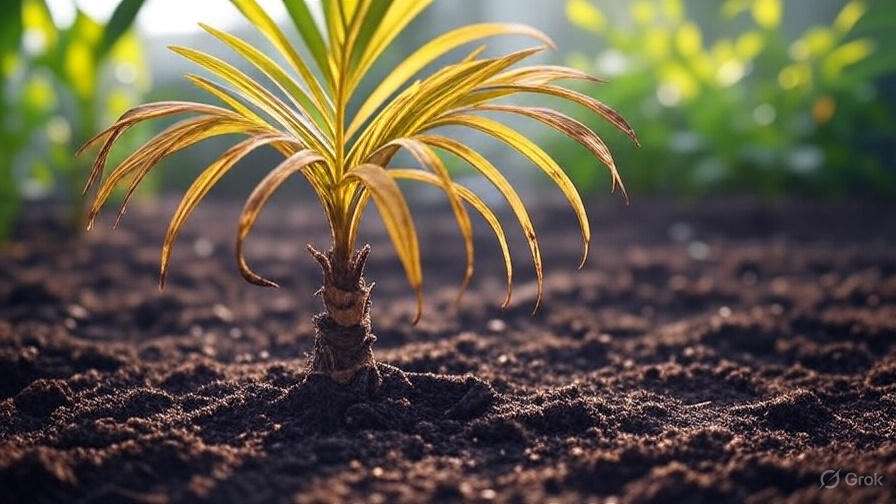
Conclusion 
Taking care of a Tree Royal Palm can be a rewarding experience, especially when you see it thrive with its elegant, tropical beauty. By providing the right environment, regular maintenance, and keeping an eye out for common issues, you can ensure your palm remains healthy and vibrant for years to come.
Remember, consistency is key—whether it’s watering, feeding, or adjusting the light levels. With a little patience and attention, your Tree Royal Palm will reward you with lush foliage and an exotic flair in your home or garden.

Don’t be discouraged by a few hiccups along the way. By following the tips and troubleshooting advice in this guide, you’ll be equipped to handle any challenge that comes your way. 
Frequently Asked Questions(FAQ)
How often should I water my baby palm tree?
Water your baby palm tree every 1-2 weeks, depending on the climate and soil conditions. Ensure the soil is evenly moist but not soggy. If the top inch of soil feels dry, it’s time to water.
Why are the leaves of my baby palm tree turning yellow?
Yellowing leaves can be a sign of overwatering, underwatering, or nutrient deficiencies. Check for signs of both issues—yellowing usually indicates water stress or lack of essential nutrients like nitrogen.
How much sunlight does a baby palm tree need?
Baby palm trees thrive in bright, indirect light. Direct sunlight may burn the leaves, so place your palm in a spot that gets filtered light for several hours each day.
Can I keep my baby palm tree indoors?
Yes, baby palm trees can grow indoors, especially in bright, indirect light and warm, humid conditions. Ensure your indoor space has enough light and temperature stability to support healthy growth.
When should I repot my baby palm tree?
Repot your baby palm tree when the roots start to outgrow the pot or if the soil drains too quickly. This typically happens every 1-2 years or when the palm’s growth slows down.
What type of fertilizer should I use for my baby palm tree?
Use a slow-release, balanced fertilizer designed for palm trees. Apply it during the growing season (spring and summer) to provide essential nutrients like potassium and magnesium for healthy growth.
How do I prevent pests from attacking my baby palm tree?
Prevent pests by maintaining good soil drainage, avoiding overwatering, and inspecting your palm regularly for signs of insects. If pests like mealybugs or aphids appear, treat the plant with natural remedies like neem oil.
Why is my baby palm tree growing so slowly?
Slow growth can be caused by insufficient light, improper watering, or nutrient deficiencies. Ensure your baby palm tree gets enough indirect light, water regularly without overwatering, and provide a balanced fertilizer to boost growth.




